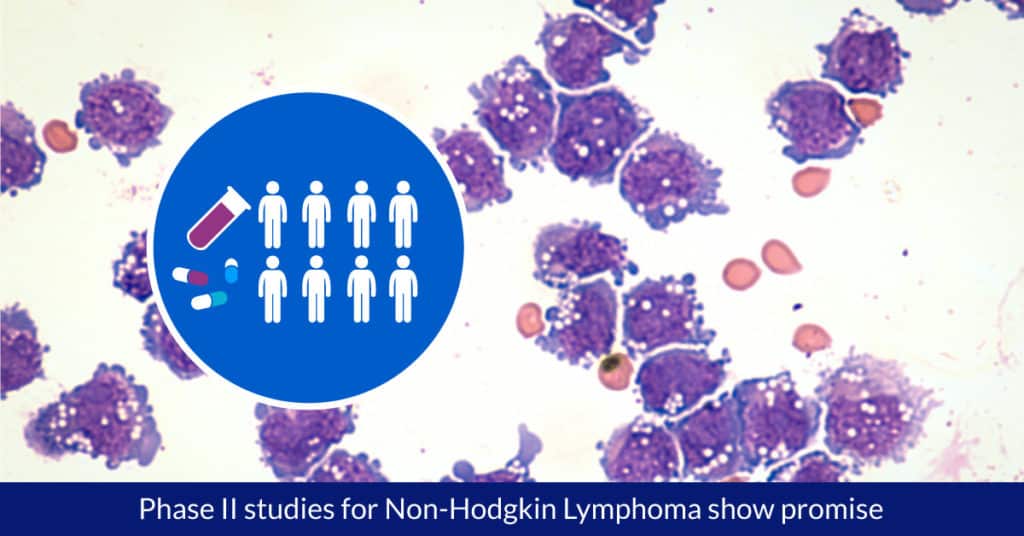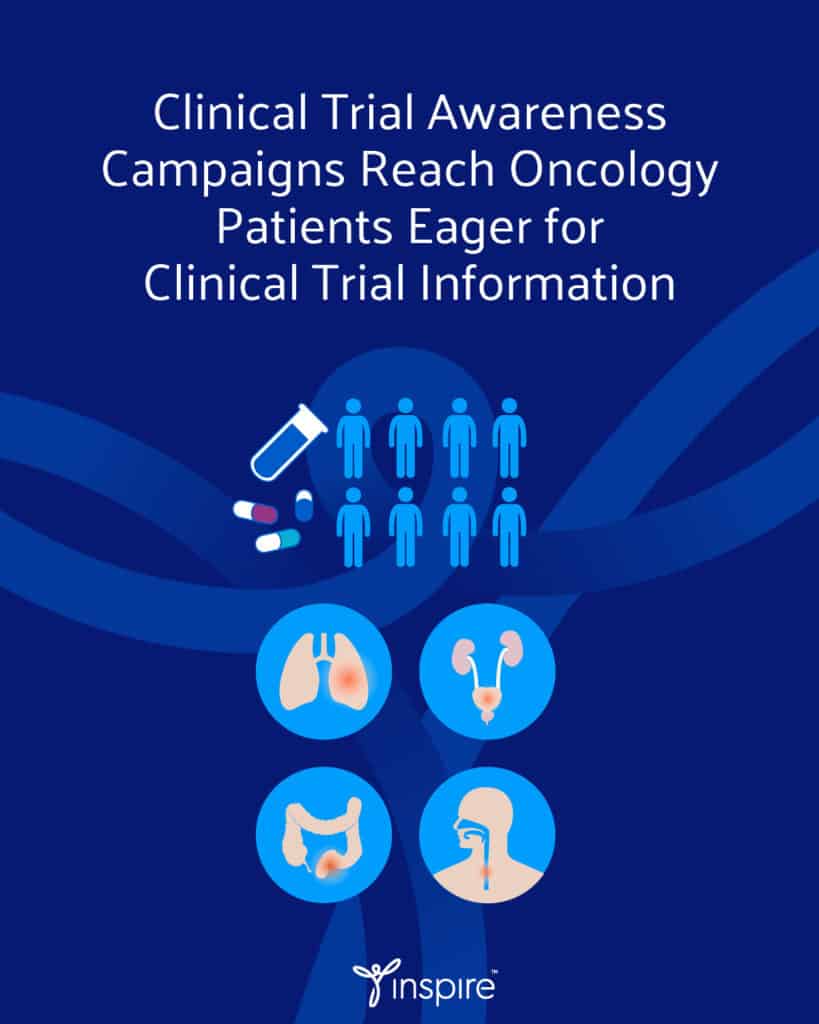Phase II studies for Non-Hodgkin Lymphoma show promise

By Kathleen Hoffman, PhD, MSPH
Let’s talk about lymphoma: Cancer of the lymphocytes, formed in the bone marrow and thymus that circulate in the lymph system. A previous post covered updates on research and treatments of Hodgkin Lymphoma, a cancer characterized by the presence of abnormal cells called “Reed-Sternberg” cells.1 Non Hodgkin Lymphoma (NHL) is any type of lymphoma that isn’t Hodgkin Lymphoma.
Four percent of the cancers diagnosed in the US in 2021 are expected to be NHL, with about 81,560 new diagnoses.2 With over 60 different types of NHL,3 patients and caregivers on Inspire often search for others who have the same type:
Does anyone have fast-growing Extranodal zone lymphoma?
[I was] diagnosed with double-hit non-hodgkins lymphoma. I am looking for other DHL patients, survivors, caregivers to share support, strength, etc … I hope everyone is well and staying strong.
Despite the diversity in types of NHL, it is possible to classify them in three different groups: Indolent (slow growing), such as follicular lymphoma; aggressive, such as diffuse large B cell (DLBCL) and mantle cell lymphomas; and highly aggressive, such as one affecting only 2.5% of NHL patients, Burkitt lymphoma (BL). Of all the NHL types, the two largest segments are follicular and DLBCL lymphomas, 25 and 30%, respectively.4
Hopeful news from several Phase II NHL treatment studies has been released in 2021:
Developments in Monoclonal Antibody Research
Epicoritamab is a monoclonal antibody that is “bispecific,” meaning it targets two markers on a cell surface instead of just one. In this case, it targets both CD3 and CD20, markers specific to T and B cell lymphomas, making the cancerous cells visible to the patient’s immune system thus activating their T-cells to kill the CD20-positive malignant B cells.5 The results of the Phase I/II study, published in September 2021, sought to determine the safety margin of doses to patients with relapsed, progressive, or refractory CD20+ mature B-cell NHL.
In the 68 patients tested, “No dose-limiting toxic effects were observed, and the maximum tolerated dose was not reached.” This is good news, but so were the response rates to the drug. The response rate among the patients was 68%, with 45% of the patients achieving a complete response at full doses of 12-60 mg.6
Mosunetuzumab and Glofitamab are also bispecific monoclonal antibodies targeting CD3 and CD20 that are undergoing clinical trials. The manufacturer, Roche, presented data for each study at the 2021 ASCO Annual Meeting.7
A Phase I/II study of mosunetzumab (GO40516) tested its effectiveness and safety when used with another approved drug for DLBCL, polatuzumab vedotin-piiq. The data presented found that the combination regimen resulted in a complete response for 54.5% in all patients, 88% of whom had aggressive NHL, and had an acceptable safety profile.7
The Phase I study of glofitamab (NP30179) tested its effectiveness on heavily pretreated patients with relapsed and refractory NHL. The data presented found that, at a median 6.3 months follow-up, glofitamab showed a “complete metabolic response rate, defined as the disappearance of metabolic tumour activity, of 71.4% in patients with aggressive (fast-growing) NHL.” 7
Another Phase II study explored using Nivolumab, a PD1 inhibitor, as a “primer” for subsequent treatment of follicular lymphoma (FL) with Nivolumab plus Rituximab. The study authors cited that, while effective, 75% of patients experienced grade 3-5 adverse events (AEs) with the standard of care. They wanted to test the efficacy and safety of using nivolumab alone first, followed by treatment with nivolumab plus rituximab, as a front-line treatment for FL, with the theory that leading with the PD1 inhibitor before tumor-directed therapy might be easier on patients.8
The results were very promising: There was an overall response rate (ORR) of 92% of the 39 patients, and a complete response (CR) in 54%. Adverse effects of grade 3 or higher dropped to 41% at the end of induction. The authors concluded that the high rates of both ORR and CR, combined with more favorable toxicity, warranted further study of this treatment as an alternative to chemotherapy.
Developments in CAR-T Cell Therapy Research
The results of the Phase II ELARA trial, also presented at ASCO 2021, showed that treatment with tisagenlecleucel led to an overall response rate of 86% in patients with follicular lymphoma. Cytokine release syndrome (CRS) is the most common adverse event associated with CAR-T therapies, and while nearly half of the 97 patients tested had grade 1 or 2 CRS, none experienced grade 3 or 4. 9
Axicabtagene ciloleucel (axi-cel) is an approved CAR-T therapy for follicular lymphoma and certain kinds of large B-cell lymphoma.10 The ZUMA-5 Phase II trial (NCT03105336) sought to test its effectiveness on a group of patients with relapsed/refractory (R/R) indolent non-Hodgkin lymphoma (iNHL) that had also had two or more previous lines of treatment. Eighty-one of the 129 patients had the high-risk feature of disease progression within 2 years of anti-CD20 chemoimmunotherapy; 48 of the patients did not have that high-risk feature.
The results evaluated 98 of the patients. It showed a 92% overall response rate, whether or not the patient had the high-risk feature of disease progression. Remarkably, 61 of the high risk patients had a complete response rate of 75%, and the 37 who didn’t had an 86% complete response rate. The authors concluded that the drug had high and durable efficacy rates in both groups.11
Diverse Cancers, Diverse Patient Experiences
Altogether, over 70 different kinds of lymphomas have been identified. The lymphomas can be grouped, but each patient has a unique experience. Inspire provides a rich resource of collective experiences for both lymphoma patients and lymphoma researchers.
Inspire offers a trusted community to patients and caregivers. Our goal with this blog, this website and our content is to provide the life science industry access to the true, authentic patient voice. In so doing, we support faithful operationalization of patient-centricity. Take a look at our case studies, eBooks and news outlet coverage.
References:
1https://corp.inspire.com/blog/hodgkin-lymphoma-research-updates-asco-esmo-2021/
2https://www.cancer.org/cancer/non-hodgkin-lymphoma/about/key-statistics.html
3https://lymphoma-action.org.uk/types-lymphoma/non-hodgkin-lymphoma
4https://allbloodcancers.org/webinars/chronic-lymphocytic-leukemia-non-hodgkin-lymphomas-new-and-emerging-treatments/
5https://journals.lww.com/oncology-times/fulltext/2021/09050/subcutaneous_epcoritamab_for_b_cell_non_hodgkin.11.aspx
6https://www.thelancet.com/journals/lancet/article/PIIS0140-6736(21)00889-8/fulltext
7ttps://www.roche.com/media/releases/med-cor-2021-06-04.htm
8https://meetinglibrary.asco.org/record/198833/abstract
9https://www.amc.com/view/asco-2021-recap-leukemia-lymphoma
10https://www.cancer.gov/publications/dictionaries/cancer-terms/def/axicabtagene-ciloleucel
11https://www.practiceupdate.com/content/asco-2021-recommendations-from-dr-noel-milipied-for-lymphoma-and-cll/118994






